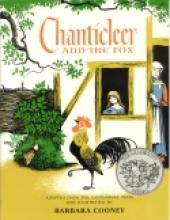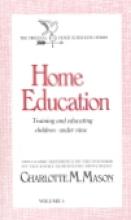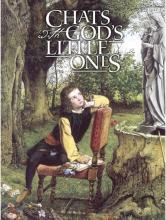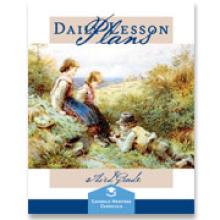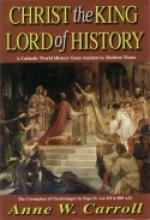No name
Chanticleer and the Fox
Charles and Emma
While the book could be read by a younger audience, the book contains too many narrow and misleading religious statements to be read by a child without the ability to see through these serious faults. It does give a deeper perspective regarding religion in 19th century England and the faith of Charles and Emma Darwin, though unfortunately through an anti-religious filter.
Charlotte Mason's Original Home Schooling Series
6 volume set, reference work for adults.
Living books instead of textbooks for teaching. "Narration" or retelling what one has read, rather than fill-in-the-blanks workbooks. Short lessons of 10 to 30 minutes, leaving time for handicrafts and exploration in the afternoon. Plenty of time outside in God's creation, learning to draw and identify plants and animals. If you are using any of these ideas in your homeschool, you may owe a debt of gratitude to Charlotte Mason.
Charlotte Mason was a British Anglican educator of the nineteenth century. She founded a set of schools in Britain and also wrote a 6 volume series of books explaining her ideas and philosophy. These books have influenced many homeschoolers, including Catholic ones, whether directly or indirectly.
Charlotte Mason was an Anglican educator of the 19th century who had a significant influence on British educational thought. Her 6 volume set of books laying out her philosophy of education is still read today, particularly by homeschoolers who are attracted to her vision of a more natural education based on excellent books.
More and more Catholic homeschoolers are feeling her influence whether directly or indirectly. She believed strongly that the overriding principle of educational philosophy should be that children are "born persons" and that they should be treated as such. They should be given access to the thoughts and creativity of great minds expressed in literature, art and music, not isolated in a childish ghetto of "twaddle" - which was her word for teaching materials that talk down to the child. She believed that the hours spent in educating a child should be largely devoted to these "living" ideas, and that plenty of time should be allowed for free play, exploration of materials and most of all, time outdoors to strengthen and invigorate body and mind.
Of the six books, the first one Home Education: Training and educating children under nine is directed at mothers of children ages 6 to 9, assumed to be at home receiving the basics of literacy under the tutelage of the mother or a governess. It attempts to lay a foundation of training in good habits and knowledge of and reverence for God. It tells us that home is the best environment for young children, that obedience and attentiveness are foundational habits upon which all others build, that mothers owe a "thinking love" to their children, and that bad habits should be uprooted at the source before they have a chance to flourish. It also lays out some practical advice for teaching the basics of reading, ciphering, nature study and Bible study.
The second one, School Education, is subtitled "Developing a Curriculum" and discusses how to apply her educational philosophy to choosing a course of study for children in the middle grades. One particularly interesting feature of this volume is the Appendix, which gives sample exam questions and answers by typical students on different levels. It is helpful to look at not only to show the breadth and depth of learning a child can acquire but also to evaluate older children who are being taught by these methods.
The third volume, Parents and Children, is subtitled "The role of the parent in the education of the child". It has as its main premise the truth that families, not individuals, are the building block of society, and summarizes the thoughts of some scientists, psychologists and sociologists of the time in light of this premise. It tells how parents should rule, inspire, train, and teach their children.
Volume 4, Ourselves, is subtitled "Improving character and conscience" and is an attempt to discuss conscience and will in the light of her educational philosophy laid out in her other books. It has an allegorical theme of "The Kingdom of Mansoul" and is directed to children of (I would say) high school age. The fifth volume, Formation of Character: Shaping the child's personality is largely a series of stories written to illustrate how to develop character in children. It starts with a series of episodes identifying problem situations with children in home life - Kitty, who has the attention span of a butterfly, Guy, who falls into intense fits of rage, Agnes, who broods and sulks - and gives ideas on how to deal with these situations. The second part offers some biographies of individuals with particular emphasis on what influenced the development of their personalities. These two books seem more dated to me, perhaps because of the story format in which they are written.
The last one, called A Philosophy of Education and subtitled "Curiosity -the pathway to creative learning" is more generally written to other educational philosophers and defends the value of a "liberal education" for every child, not just those of the upper classes. Since it talks about what the goal of education should be, and what kind of citizen should be result, it is interesting to read for someone whose children are in high school and preparing to go out into the world.
A recurring theme of all the books is the gospel admonition that we must not, "Offend not, despise not, hinder not" the children or keep them from truth. She maintains that authority and obedience are the most important moral principles and the axis upon which all other moral laws must balance. The worst offense of parents against children is that they misunderstand and misuse this principle either by being arbitrarily harsh or arbitrarily mild. She contends that parents are not given children as property but as trusts to God and society, which they must fulfill responsibly. These are all, of course, in accordance with Catholic doctrine (see The Catechism of the Catholic Church on family and morals). Educational institutions are subordinate to the family and child, and a liberal education (by which she meant one fitted to expand the child's horizon) should be the birthright of everyone, not just a selected few.
Some have criticized some of Charlotte Mason's philosophies as un-Christian or un-Catholic. One example is her contention that "children... are not born either good or bad, but with possibility for good and evil." Some have felt that this denies original sin and allies Charlotte Mason with modern humanism. My sense from the context of her words is that she is making a distinction between original sin and actual sin. The fact is that an infant has never committed a personal sin, and that the sacrament of Baptism wipes out even the stain of original sin, while leaving a tendency to concupiscence. In this light, what she is saying is that any child can become a saint or a demon as a result of what they do during their lives. If you read her words in this way they are thoroughly orthodox and were stated as a counter to the Calvinism of her time, which contended that small infants were corrupt limbs of Satan and that the evil must be punished out of them.
Another criticism is that she spoke approvingly of thinkers like Rousseau who were violently anti-Christian and anti-Catholic. In fact, she did think it important to reference and discuss the works of philosophers of her time who had a wide influence, but her seeming object in doing so was to sort out what was true in their thought from what was false and dangerous.
There are parts of her books that will seem quaint, outdated and even self-contradictory to the reader. Some examples are the way she emphasizes wearing wool as superior to cotton or linen; or discusses the latest scientific theories that habits leave physical imprints on the brain. These types of things have to be taken in their historical context and referred to a more general principle - that physical health is important for mental health and that habits are the building blocks of virtue (these, of course, are also thoroughly Catholic principles). I find some of her specific precepts on training children a little bit impracticable and discouraging - she will say that a child should be trained in good habits, but without recourse to "direct use of fear or love, suggestion or influence, or by undue play upon any one natural desire". I am assuming she believes that a child's motive for doing well should be "for love of the good Lord" as St Therese's family taught her, but it is not altogether clear by exactly what steps one should guide one's child towards this highest and best of all motives.
And of course, lastly, this is not a Catholic series and one will not find mentions of the sacraments as the best ways to nourish the virtues in a family.
In general, this is a valuable series for the home schooling family. It is not an easy read. The most useful way I have found to read the books is to pick them up a little at a time. If you want a friendly introduction to Charlotte Mason's ideas, I recommend Karen Andreola's A Charlotte Mason Companion" or Susan Schaeffar Macaulay's "For the Children's Sake" (both written from a Protestant perspective). There are also several resources on the web.
Additional Comments: Although I bought the six volume series written by Miss Mason herself, I found it very slow going and hardly dipped into series. I recommend reading the books by Mrs. Macaulay and Mrs. Andreola before purchasing this series.
- Alicia Van Hecke (3-26-01)
Chats With God's Little Ones
Chats With God's Little Ones is a unique Catholic religion course for the youngest of students from pre-kindergarten up through the second grade. Written to the teacher, the lessons are designed to be used orally with the student in a Charlotte Mason three-step style of asking the child, answering with the child, and the re-telling by the child. The lessons are presented as guided scripts for the teacher, who can personalize them and adapt them to the needs and interest of the child. In the words of the author, "I have written a step by step guide to enable you to arouse the child's interest, apply the Faith to his daily life, and convey to him your love of Jesus and Mary and of the child himself. Our chief aim, after all, is to inflame his heart with love of God and His Holy Mother, and enkindle in him the desire to please God."
Chats With God's Little Ones is a 94 page, spiral-bound book with a laminated over. The binding allows the book to lie flat so that is can be used during the lesson time with the child. At first glance, the book seems very simple; it isn't! There are 63 lessons of new material arranged into 24 chapters, in addition to 24 review lessons, one at the end of each chapter. The lessons begin with the teaching of the basic Catholic prayers and the meaning of these prayers. The lessons continue with instruction in all of the basic catechism lessons, intermixed with an introduction to Bible History. The back of the book includes simple drawings and suggestions for art projects for each of the chapters. This is a full-year religion course for Pre-K, Kindergarten, and First Grade. It is designed to also be used in the first semester of Second Grade, with sacramental preparation taking place in the second semester.
I really like this course, and I am using it both in Kindergarten as an introduction to our Faith and in First Grade, with an eye toward mastery and understanding. In our family, we tend toward a Charlotte Mason-based approach in the youngest years, and the style of this course fits in very nicely.
CHC Lesson Plans: 3rd Grade, Appendix Three "At the Feet of Mary: Holy Rosary Project"
30 sheet supplement to the larger resource reviewed here.
This rosary resource includes a cut-and-color rosary booklet featuring half-page illustrations on each of the 20 mysteries of the Rosary by Anna May McCallum. This project is designed to cover five weeks - an introductory week and one week each for the Joyful, Luminous, Sorrowful and Glorious mysteries of the Rosary. This resource also provides instructions for compiling the book (along with the child's own meditations on each mystery), suggested book, movie and game ideas, meditations on each of the mysteries of the Rosary (including commentary by the Pope from his encyclical on the Holy Rosary) and beautiful commentaries on four great Shrines in Europe from a young girl who visited them (Loreto, Lourdes, Rue-de-Bac and St. Peter's Basilica). A very beautiful resource.
Chemistry 001
Christ and the Americas
Christ the King Lord of History
The Controversy: We're not supposed to "whitewash" the Catholic Church's role in History. The fact that there have been many bad Catholics and that bad things have been done in the name of the Catholic faith cannot be ignored. Anne Carroll seems to agree with this principle. Why the controversy then? According to Mrs. Carroll, many events that the Modern World believes should be blamed on Catholics are in fact Protestant myths, designed to make Catholics look bad, or other misrepresentations or misunderstandings of the facts. Some of her facts contradict other Catholic sources, such as the Catholic Encyclopedia, on such hot-button issues as the Spanish Inquisition. A number of Catholic homeschoolers find this very troubling. Some I've talked to have been so upset at their perception of a "whitewashing" of Catholic history that they are avoiding this text altogether. I disagree with this position because I believe that Mrs. Carroll genuinely believes that what she has written is true and that she is not attempting to hide the faults of the Church. I understand that some homeschoolers also prefer her husband, Warren Carroll's History of Christendom series, because it is highly annotated to support his claims and provide further reference.
I think it's important to understand that History is a very complex thing. For our understanding of History, we are always relying upon someone else's facts. Within the Catholic Church, there are many issues which are not agreed upon, and the Church doesn't say that you have to believe this or that side. I think this is a good concept for children (especially high schoolers) to understand. I would suggest having your children use this text, but discuss these important issues before you embark on your journey, and have them read materials from other Catholic sources as well.
Copyrights 1976/1986/1994
Christ the King, Lord of History - Answer Key
Which busy homeschooling mother couldn't use some extra time in her day? I used to avoid purchasing answer keys and other helps, thinking that the money was better spent in other ways. As my family has grown and my children's work has become more time-consuming and difficult, I have found real value and genuine time savings in having a well-produced answer key. I'm still able to correct first grade math without a key, but not high school history!
This new book will be a wonderful blessing to families who use this popular textbook, and I can't imagine being without it now. I'm sure that we would all agree that it is very important to check a student's work as quickly as possible to give useful feedback. Because the textbook questions are primarily short-answer and not multiple-choice and true-false questions, this process can be very time-consuming. If you do as I do and get interested in what you are reading, it takes even longer!
This key is organized by chapter, making it immediately useful no matter where in the text your student happens to be working. The answers to the chapter-end questions are precise and detailed, giving the optimal response to the question rather than a simplified version that a student might hastily write. Quotations from the textbook itself are used liberally to support the answers given. Highly recommended!

